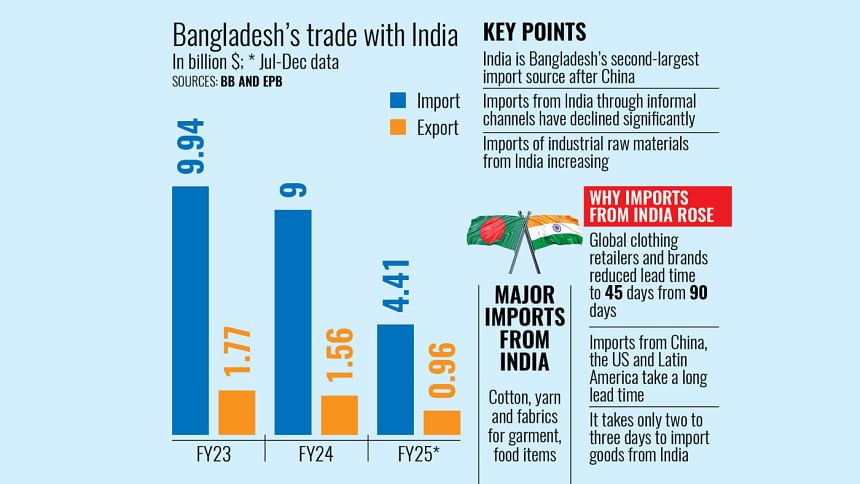Imports from India rise as exporters battle against lead time

Bangladesh's reliance on Indian imports has been increasing as local manufacturers and industries are struggling to reduce the time needed to bring in goods from other destinations as they battle to meet shrinking lead times.
If local manufacturers import raw materials from China, Latin America or Africa, they lose their competitive edge in the global supply chain, especially as international retailers and brands have lately shortened lead times.
The import of Indian goods, especially cotton, fabrics and yarn, has been increasing since July last year, when political and labour unrest disrupted export-import activities and led to a halt in production across many factories.
According to Bangladesh Bank data, imports from India increased by 2.09 percent to $2.36 billion in the October-December quarter of 2024, a year-on-year increase from the $2.04 billion recorded the year prior.
In FY24, the total import value of Indian goods to Bangladesh was $9 billion and in the FY23 the import value from India was $9.94 billion, central bank data showed.
In the first six months of the current fiscal year, the total import value from India remained on the same trajectory, hitting $4.41 billion. However, given the increasing flow of imports, it may exceed last year's number.
Cotton is among the major commodities imported from India. Bangladesh imports cotton worth more than $3 billion each year, with more than half coming from India. In FY23, imports of Indian cotton stood at $1.92 billion and climbed to $2.36 billion in FY24.
Other major commodities imported by Bangladesh from India include cotton yarn, fabrics, handloom products, and organic and inorganic chemicals.
Importers said increased trade through formal channels played a role in the rise, informing that trade through informal routes dropped significantly due to improved border vigilance by both countries.
Yet, the main reason for rising imports from India is the fact that it allows companies to preserve the most valuable commodity of all: time.
Competition in the global supply chain intensified in the aftermath of the Covid-19 pandemic, Russia-Ukraine war and high global inflation, leading international clothing retailers and brands to halve lead times from 90 days to 45 days.
But if local garment exporters import cotton from Africa, Latin America, Australia or the US, it takes at least 35 days to arrive at the Chattogram port before taking another 15 days or so to reach the mills.
So, it takes 45 days just to deliver cotton to the mills.
However, if cotton is imported from India, it takes only two to three days to get delivery, that too at cheaper prices.
Before the Covid-19 pandemic, Bangladesh had cut down on its imports of Indian cotton. The country, which used to source around 60 percent of its cotton from India, had reduced the level to below 30 percent as Indian cotton traders often stopped sending cotton to Bangladesh without any prior notice.
However, the scenario has somewhat reversed in recent times, with a resurgence in imports of Indian cotton, yarn and fabrics.
Showkat Aziz Russell, president of the Bangladesh Textile Mills Association (BTMA), whose members are the biggest importers of Indian raw materials, said local millers and manufacturers were left with little choice but to turn to Indian goods again.
"You can say we are kind of bound to rely more on Indian goods because of the changing nature of global business trends," Russell told The Daily Star over the phone.
This is because shorter lead times are the main factor in business, he said, adding that Indian cotton can be imported in two to three days.
Moreover, Indian yarn, cotton, chemicals and other industrial raw materials are cheaper, he said.
Md Abdul Wahed, joint secretary general of the India-Bangladesh Chamber of Commerce and Industry, said trade with India currently takes place through 24 land ports and three rail ports alongside airports and seaports.
So, as all the ports are operational and border security has been tightened, trade through informal channels is almost impossible now, he added.
Monsoor Ahmed, a former chief executive officer of the BTMA, said many local businessmen had no choice but to source raw materials from India as banks in other countries were reluctant to accept letters of credit (LCs) because of the US dollar shortage in Bangladeshi banks.
Mohammad Abdur Razzaque, chairman of the Research and Policy Integration for Development, said the Indian economy is complimentary to Bangladesh's industries as India is the second-largest source of industrial raw materials in the world after China.
It is also true that geographical proximity, familiarity with the language and a similar culture also contribute to higher import dependence on Indian goods, Razzaque added.
The most-imported items were cotton, manmade fibre, fabrics, cotton and non-cotton yarn, textile chemicals and others, according to data from India's Ministry of Commerce and Industry.
On the other hand, Bangladesh has hardly been able to capitalise on duty-free trade benefits with India, with exports to the country still slow because of a lack of product diversity.
Bangladesh exported $970 million worth of goods, mainly garment items, to India in the July-December period of the current fiscal year, according to data from the Export Promotion Bureau (EPB) of Bangladesh.
In FY24, Bangladesh's exports to India totalled $1.56 billion, an 11.63 percent decline from the $1.77 billion exported the previous fiscal year.

 For all latest news, follow The Daily Star's Google News channel.
For all latest news, follow The Daily Star's Google News channel. 



Comments